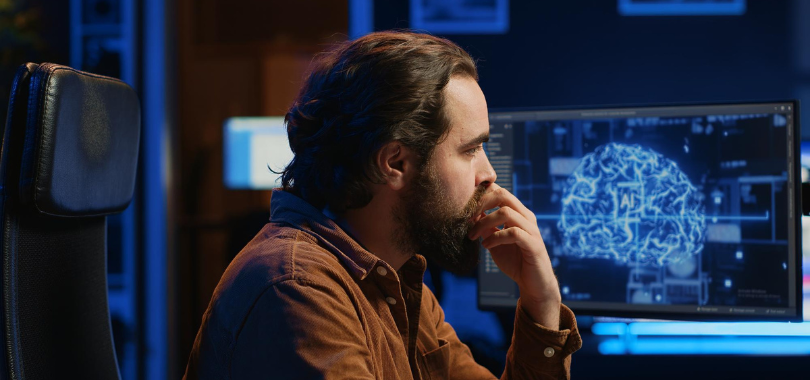AI, Upskilling, and the Game-Changing Power of Skepticism

mage Source – Freepik
Whatever field you are in, there’s a good chance that artificial intelligence (AI) has started seeping into your day-to-day activities. The rest of your organization, across all levels and departments, might also be dealing with this disruption in their own ways, too. Add to that internal complexity the technical, legal, and economic vines twining and creeping through the general AI conversation. That makes it easy for us to fall into the AI-nxiety trap, intensified by the question “Am I going to be replaced by machines?”
However, if we look closely, there’s a good problem lurking around: The more technology we make, the more we crave what it can’t make—humanity. And data shows that today, many roads lead to upskilling, as companies seek skills that help people make sense of complex situations and contexts, use judgment honed by experience, and apply knowledge in ways machines cannot.
Conscious Upskilling
According to the World Economic Forum’s (WEF) Future of Jobs Report 2025, upskilling is seen as the most common workforce strategy over the next five years and is regarded as a top priority across all geographies and economies at all income levels. Upskilling is expected to address skill gaps, considered the foremost challenge in business transformation. Moreover, 69% of the surveyed employers plan to hire AI-skilled talent, and 62% will focus on hiring workers who can collaborate with AI.
To increase talent availability over the next five years, 63% of employers are prioritizing reskilling and upskilling opportunities, which come after employee health and well-being in terms of business practices. Meanwhile, 70% of employers aim to hire professionals with in-demand skills, while 51% consider moving people from eroding to progressing roles internally, and 41% foresee a reduction in staff due to outdated skills. Although work experience remains the top mechanism in screening prospective employees, skills assessments come second, as indicated by 48% of the respondents. Parallel observations are present elsewhere, from the IBM Institute for Business Value (IBM IBV) survey to LinkedIn’s Work Change Report, and from the United States to Asia Pacific.
Read More >> How Is the Skills-First Approach Redefining the Workforce?
Upskilling comes with several facets and components that are shaped by how organizations approach it. IBM suggests that an AI upskilling strategy must incorporate five tools: computer vision, generative AI, machine learning (ML), natural language processing (NLP), and robotic process automation. However, it is important to recognize that these areas differ significantly in scope and complexity. AI technologies, as noted by IBM, can also enhance learning experiences by supporting online learning and development, on-the-job training, skill-gap analysis, and mentorship.
The general principle of upskilling is to keep humans at the forefront, as Daron Acemoglu, an Institute Professor at the Massachusetts Institute of Technology (MIT) and Faculty Co-Director of MIT’s Shaping the Future of Work Initiative, similarly expressed in an article. He argued that AI won’t replace entire professions like journalism or HR and emphasized that AI should be developed to provide “expertise and information to workers.”
Creating an AI-focused upskilling program not only requires designing a structure for skill evaluation and learning experience but also engaging in active dialogue with employees about their capabilities, aspirations, and opportunities in this evolving space. Here’s an example: To fill 100,000 high-paying, in-demand roles over the next four years, Walmart is investing in its employees by expanding career growth programs. These include Walmart Academy for global training, Live Better U for free GED classes, college programs, and certifications, and a “career explorer,” i.e., an AI tool that recommends career paths based on employees’ interests. The company has also launched several upskilling initiatives to boost professional development.
Professionals can also take charge of their own growth. Programs like the Certified AI Enablement Professional course empower them to use AI technologies in different areas of their work environments. Designed by maentae, a progressive learning solution provider, the course is grounded in the AI Enablement Framework, a collaborative effort between the Functional Areas Enablement Institute (FAEI) and The KPI Institute. Participants will learn about NLP, prompt engineering, AI readiness evaluations, strategic AI road mapping, and AI solution deployment.
Conscientious Skepticism
Upskilling for AI adoption is not a walk in the park, as skepticism and resistance can emerge. In his article in the Chief Data Officer Magazine, Danny Abdo, chief operations officer of learning platform Skillable, explained that employees resist AI transformations due to multiple factors, including a lack of knowledge on how to incorporate new tools and fear of job displacement by automation.
Interestingly enough, this very reluctance is what pushes us to define our roles and establish safeguards as AI penetrates our systems. In terms of upskilling, the method and execution take on a more strategic and people-centric direction. For instance, Abdo emphasized that hands-on practice with AI technology is the key to helping employees feel more comfortable: “You need AI upskilling that mimics what someone will use the tool for in their everyday lives, in a safe environment where they can make mistakes and not compromise data or operations.”
Discussions about organizational readiness for AI adoption are also indispensable. Readiness programs should not train employees to blindly accommodate new tools but to control their use in ways that deepen their effectiveness in their roles. Organizing human-AI collaboration can provide clarity, certainty, and coherence. The more defined and structured the collaboration between humans and AI, the less likely it is that automation displaces the deep understanding and adaptability that humans bring to the world. However, it’s not just about frameworks. Human-AI collaboration may still introduce technical challenges, such as interpretability, misalignment with user intent, and overreliance on automated outputs, all of which require research-informed approaches and trust calibration mechanisms.
Partnership on AI (PAI), describing itself as “a nonprofit partnership of academic, civil society, industry, and media organizations creating solutions so that AI advances positive outcomes for people and society,” developed a Human-AI Collaboration Framework that contains 36 questions outlining characteristics that distinguish examples of human-AI collaborations. “By drawing attention to the nuances—including the distinct implications and potential social impacts—of specific AI technologies, the Framework can serve as a helpful nudge toward responsible product/tool design, policy development, or even research processes on or around AI systems that interact with humans,” PAI’s document states.
Read More >> Lessons From Global Leaders: How AI Is Changing Public Service Delivery
It is important to realize that challenges related to the control, security, legality, and ethical use of AI would not arise if the technology were capable of functioning on its own accord. It strongly signifies the need for human oversight, including interpretation, training, and troubleshooting. Reflecting that, the WEF’s report highlights that employers consider analytical thinking, resilience, flexibility, agility, leadership, social influence, creative thinking, motivation, and self-awareness as the top core skills for their workforce. These skills would allow us to work alongside AI, lead its integration, and adapt to its evolving capabilities.
AI as a Test
AI skepticism is not only natural but necessary. A healthy dose of it has its purpose in upskilling, especially if we want safe and meaningful growth instead of reckless adoption. What must be avoided is unguided skepticism, which can become an overblown reflex that overcomes reason. Conscientious skepticism is about moving beyond the belief that the journey of aligning with AI is linear and unbending. It’s more about being proactive rather than reactive, countering fears with facts, intellectual humility, and thoughtfully coordinated approaches. Only then can one have room to put into practice the identified core skills that employers seek, from flexibility to creativity to leadership, attributes that also support holistic personal growth.
Therefore, companies must avoid measuring success solely through technological metrics and instead establish a well-defined and resilient approach to AI integration. Overreliance on technology carries its own risks and shortcomings, with societal impacts that may become difficult to reverse over time. In this regard, AI serves not just as a tool but as a test of whether organizations and individuals can use technology in a way that is rooted not in hype but in insight, adaptability, and ethical responsibility.
To learn more about AI’s role in the workplace and beyond, stay tuned for the next edition of Performance Magazine and follow The KPI Institute’s LinkedIn page for updates.
**********
Editor’s Note: This article was originally published in Performance Magazine Issue No. 32, 2025 – Employee Performance Edition.

